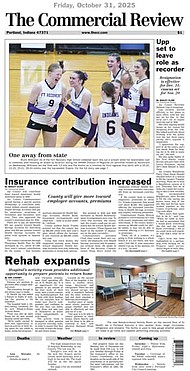February 18, 2016 at 6:28 p.m.
Nowhere in the state is there a higher percentage of children living in poverty than in Jay County.
Indiana Youth Institute’s Kids Count in Indiana 2016 Data Book released this week shows the county has a childhood poverty rate of 35.2 percent. That leads the state at nearly four percentage points higher than Marion County (Indianapolis), which was second, and 14 percentage points higher than the Indiana average.
“That’s pretty alarming,” said Jay County Commissioners president Faron Parr. “You sure don’t want to be No. 1 for that.
“That tells you that there is a problem, a bigger problem probably than most people realize.”
The county was also sixth in the child abuse and neglect rate at 36.7 per 1,000.
The child poverty numbers are part of the annual report from IYI, a non-profit focused on improving child development. They are based on United States Census Bureau data from 2014.
Jay County’s child poverty numbers have consistently ranked among the highest in the state over the course of the last decade, but showed a spike in 2014. After coming in between 24.7 and 27.2 percent over a six-year span from 2008 through 2013, the rate locally jumped by seven percentage points in 2014 and was one of only three in the state higher than 30 percent.
IYI interim president and CEO Glenn Augustine said typically such a spike comes when a major employer closes or there is an influx of new residents who may have lower-paying jobs.
Neither of those were the case in Jay County, said Jay County Development Corporation executive director Bill Bradley.
The largest plant closures over the last few years came at Jay Products (80 employees) in 2013 and Hartzell Air Movement (44 employees) in 2014.
“Sometimes it’s not as obvious why it’s happening,” said Augustine. “It often is hard to put a finger on why it happened unless you’ve had some sort of big event that makes it fairly obvious.”
Child poverty is an issue throughout the six-county region, as Adams, Blackford, Randolph and Delaware counties also had rates of 23.5 percent or higher in 2014. Only Wells County has performed consistently well, posting the 17th-lowest child poverty rate in the state in 2014 at 15.8 percent.
Those numbers cause a variety of problems, but they boil down to a couple of key worries.
“Children are going hungry,” said Andy Glentzer, executive director of Community and Family Services, which administers programs such as WIC, energy assistance and Head Start in Jay, Adams, Blackford, Randolph Wells and Huntington counties, echoing concerns raised by Augustine. “Children are not properly being cared for.”
Participation in most programs through CFS has seen an increase, Glentzer said.
Augustine noted several tools that can be used to mitigate the impact of child poverty, many of which run through school systems and have already been implemented in Jay County. Those include a school breakfast program and connecting students with community resources such as United Way for food, housing and clothing.
Jay School Corporation superintendent Tim Long pointed to the percentage of students in the county who qualify for free and reduced lunch, saying it was 32 percent when he took his job about a decade ago and is now approaching 60 percent. On Monday, Jay School Board approved participation in the federal summer lunch program, which has provided more than 40,000 meals in the county over the last four years.
Long has also served as president of the board of directors for United Way of Jay County, which holds a monthly free food tailgate.
“When you talk about a community of this size, and you’ve got 600 cars of people lined up to get food every month, that’s a telling thing,” he said. “There’s a lot of things that come with poverty, a lot of issues that come with it. Typically people in poverty have more problems than people that are not when it comes to raising their kids …
“We just try to be as efficient and effective as we can with dealing with those needs.”
While it can be difficult to pinpoint solutions to child poverty, education is key, said Augustine.
High school graduation rate is one of the areas in which Jay County fares well — 12th highest in Indiana at 95.6 percent — but Long noted a need to raise the number (about 48 percent) of students who go to college. That issue has been a focus in a variety of ways, including expanding higher education offerings through John Jay Center for Learning and helping residents save for post-secondary education through Jay County Promise.
“I think we’ve really committed ourselves in this county that if people are going to lift themselves out of poverty it’s going to be through education,” said Bradley. “I think that’s very important. … I think that’s the course we’re on.
“It’s a long-term course. It’s not going to answer every question tomorrow, but I think in the long term that will help the citizens of Jay County.”
Given the numbers released this week, Parr said he and his fellow commissioners will be looking at the issue, both to try to pinpoint the reasons for the high rate of child poverty and to find potential solutions.
That, Augustine said, is a good first step.
“One of the things we hope with the Kids Count Data Book is people take a look at it not only on a state-wide level but on a local level and say, ‘What are the issues we’re facing in our community and how can we as a community react to those issues? What resources can we put to bear in the community to try to make a difference in those issues?’” he said. “Those conversations often are the start to solutions that will arise later.”
Indiana Youth Institute’s Kids Count in Indiana 2016 Data Book released this week shows the county has a childhood poverty rate of 35.2 percent. That leads the state at nearly four percentage points higher than Marion County (Indianapolis), which was second, and 14 percentage points higher than the Indiana average.
“That’s pretty alarming,” said Jay County Commissioners president Faron Parr. “You sure don’t want to be No. 1 for that.
“That tells you that there is a problem, a bigger problem probably than most people realize.”
The county was also sixth in the child abuse and neglect rate at 36.7 per 1,000.
The child poverty numbers are part of the annual report from IYI, a non-profit focused on improving child development. They are based on United States Census Bureau data from 2014.
Jay County’s child poverty numbers have consistently ranked among the highest in the state over the course of the last decade, but showed a spike in 2014. After coming in between 24.7 and 27.2 percent over a six-year span from 2008 through 2013, the rate locally jumped by seven percentage points in 2014 and was one of only three in the state higher than 30 percent.
IYI interim president and CEO Glenn Augustine said typically such a spike comes when a major employer closes or there is an influx of new residents who may have lower-paying jobs.
Neither of those were the case in Jay County, said Jay County Development Corporation executive director Bill Bradley.
The largest plant closures over the last few years came at Jay Products (80 employees) in 2013 and Hartzell Air Movement (44 employees) in 2014.
“Sometimes it’s not as obvious why it’s happening,” said Augustine. “It often is hard to put a finger on why it happened unless you’ve had some sort of big event that makes it fairly obvious.”
Child poverty is an issue throughout the six-county region, as Adams, Blackford, Randolph and Delaware counties also had rates of 23.5 percent or higher in 2014. Only Wells County has performed consistently well, posting the 17th-lowest child poverty rate in the state in 2014 at 15.8 percent.
Those numbers cause a variety of problems, but they boil down to a couple of key worries.
“Children are going hungry,” said Andy Glentzer, executive director of Community and Family Services, which administers programs such as WIC, energy assistance and Head Start in Jay, Adams, Blackford, Randolph Wells and Huntington counties, echoing concerns raised by Augustine. “Children are not properly being cared for.”
Participation in most programs through CFS has seen an increase, Glentzer said.
Augustine noted several tools that can be used to mitigate the impact of child poverty, many of which run through school systems and have already been implemented in Jay County. Those include a school breakfast program and connecting students with community resources such as United Way for food, housing and clothing.
Jay School Corporation superintendent Tim Long pointed to the percentage of students in the county who qualify for free and reduced lunch, saying it was 32 percent when he took his job about a decade ago and is now approaching 60 percent. On Monday, Jay School Board approved participation in the federal summer lunch program, which has provided more than 40,000 meals in the county over the last four years.
Long has also served as president of the board of directors for United Way of Jay County, which holds a monthly free food tailgate.
“When you talk about a community of this size, and you’ve got 600 cars of people lined up to get food every month, that’s a telling thing,” he said. “There’s a lot of things that come with poverty, a lot of issues that come with it. Typically people in poverty have more problems than people that are not when it comes to raising their kids …
“We just try to be as efficient and effective as we can with dealing with those needs.”
While it can be difficult to pinpoint solutions to child poverty, education is key, said Augustine.
High school graduation rate is one of the areas in which Jay County fares well — 12th highest in Indiana at 95.6 percent — but Long noted a need to raise the number (about 48 percent) of students who go to college. That issue has been a focus in a variety of ways, including expanding higher education offerings through John Jay Center for Learning and helping residents save for post-secondary education through Jay County Promise.
“I think we’ve really committed ourselves in this county that if people are going to lift themselves out of poverty it’s going to be through education,” said Bradley. “I think that’s very important. … I think that’s the course we’re on.
“It’s a long-term course. It’s not going to answer every question tomorrow, but I think in the long term that will help the citizens of Jay County.”
Given the numbers released this week, Parr said he and his fellow commissioners will be looking at the issue, both to try to pinpoint the reasons for the high rate of child poverty and to find potential solutions.
That, Augustine said, is a good first step.
“One of the things we hope with the Kids Count Data Book is people take a look at it not only on a state-wide level but on a local level and say, ‘What are the issues we’re facing in our community and how can we as a community react to those issues? What resources can we put to bear in the community to try to make a difference in those issues?’” he said. “Those conversations often are the start to solutions that will arise later.”
Top Stories
9/11 NEVER FORGET Mobile Exhibit
Chartwells marketing
September 17, 2024 7:36 a.m.
Events
250 X 250 AD


